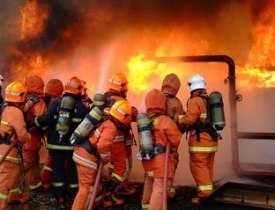Description
Course Name: Diploma in Fire Safety and Hazards Management
Course Id: DFSHM/Q1001.
Education Qualification: 10th Pass.
Duration: 370 Hrs.
How You will Get Diploma Certificate:
Step 1- Select your Course for Certification.
Step 2- Click on Enroll Now.
Step 3- Proceed to Enroll Now.
Step 4- Fill Your Billing Details and Proceed to Pay.
Step 5- You Will be Redirected to Payment Gateway, Pay Course and Exam Fee by Following Options.
Card(Debit/Credit), Wallet, Paytm, Net banking, UPI and Google pay.
Step 6- After Payment You will receive Study Material on your email id.
Step 7- After Completion of Course Study give Online Examination.
Step 8- After Online Examination you will get Diploma Certificate soft copy(Scan Copy) and Hard Copy(Original With Seal and Sign).
Step 9- After Certification you will receive Prospect Job Opportunities as per your Interest Area.
Online Examination Detail:
- Duration- 120 minutes.
- No. of Questions- 60. (Multiple Choice Questions).
- 10 Questions from each module, each carry 10 marks.
- Maximum Marks- 600, Passing Marks- 40%.
- There is no negative marking in this module.
| How Students will be Graded: | ||
| S.No. | Marks | Grade |
| 1 | 91-100 | O (Outstanding) |
| 2 | 81-90 | A (Excellent) |
| 3 | 71-80 | A (Very Good) |
| 4 | 61-70 | B (Good) |
| 5 | 51-60 | C (Average) |
| 6 | 41-50 | P (Pass) |
| 7 | 0-40 | F (Fail) |
Benefits of Certification:
- Government Authorized Assessment Agency Certification.
- Certificate Valid for Lifetime.
- Lifetime Verification of Certificate.
- Free Job Assistance as per your Interest Area.
Syllabus
Diploma in Fire safety and Hazards Management
Special Fire Hazards
Introduction to concept of Special Fire Hazard: Concept of SFH- Areas under special fire hazard; Principles of life safety and objectives, SEVESO Directive, COMAH, DSEAR regulations ATEX Directives; Basic fire safety strategy in high rise building, Categories of special structures, Aviation Fire Operations: Introduction to aircraft and parts -Materials of construction, Details of construction, Fuel tanks, construction of tanks and different aviation fuels, Different engines and APU; Aircraft fires – Engine fire, Wheel fire, Cabin fire, Vapour cloud explosion in fuel tanks, Gas Plants, Refineries, Chemical and Petro Chemical industry hazards: Fire Fighting, Fire Prevention and protection and safety measurements for the above mentioned industries; Salvage and protection from disaster fallout for these industries, Onshore, Offshore.
Fire Safety Risk Assessment
Introduction, Understanding fire: How and why people die in fires , Human behavior in fire: How people behave in emergencies, Legislative requirements: The Regulatory Reform (Fire Safety) Order 2005, Fire hazards & risks, Plan Drawing, Brief look at drawing to scale, and how plans can be used to good effect, Fire risk assessment structure and layout, Means of escape principles: Basic requirements and what to look for, Fire signage: National requirements, Fire Alarms & fire detection: Basic components, and testing, Emergency lighting: When it is required, Basic components, and testing, Alternatives to emergency lighting.
Health Safety Environment
Air pollutants – Pollution sources – automobile pollution-hazards of air pollution-concept of clean coal combustion technology, fly ash-control of combustion in combustion chambers- ultra violet radiation, infrared radiation, radiation from sun-hazards due to depletion of ozone – deforestation ozone holes-automobile exhausts-chemical factory stack emissions – CFC, Water pollutants-health hazards-sampling and analysis of water-water treatment – different industrial effluents and their treatment and disposal -advanced wastewater treatment – effluent quality standards and laws – chemical industries, tannery, textile effluents-common treatment, Hazardous waste management in India-waste identification.
Industrial Safety Management
Henrichs Axioms Of Industrial Safety ,Concepts Of Safety, Organization For Safety, Organization, Definition, Need & Principles Organizing For Health ,And ,Environmental, Activities, Organization Structure, Function & Responsibilities, Directing For Safety, Direction, Definition, Process, Principles and Techniques Leadership, Role, Function And, Attributes Of A Leader, Safety Management System, Objectives of Health, Safety and Environment Policy, Responsibility for Implementation of HSE Policy, Role of Occupier and Factory Manager, Factory Safety Committee, Structure and Functions and Working Tenure Details Etc, Definition : Incident, Accident, Injury , Dangerous occurrence.
Search and Rescue Technician
Procedures for managing and reporting exposure of all GSAR volunteers to diseases including airborne, blood borne, blood or body fluids, non-impact skin – injection, inhalation, absorption, ingestion and exposure, GSAR volunteers will exercise caution and utilize proper protective equipment where exposure to diseases is a concern. All exposures will be documented and reported to the GSAR leader and or manager, documented in the GSAR group first aid record and reported to EMBC, Proper protective equipment, including the wearing of latex gloves and face/nose/eye/mouth protection, will be utilized at all incidents where exposure is possible.
Fire Protection System
Hose, Types of hose, Characteristic, Frictional lose, Material used, Cause and prevention of mildew, Causes and prevention of shock, Causes and prevention of rubber acid, Care and maintenance, Types of hose fittings, Couplings, Component parts of inter locking couplings, Suction coupling wrenches, Branches, nozzles and branch holders, Rope, Lines, knots and ladders, Introduction, Manufacturing materials, Types of ropes and size, Cordage, Causes of deterioration of ropes and lines, Different type of knots, Different type of lines, Purpose of knots, Ladders, Introduction, Hook ladder, escape ladder, turn table and extension ladder.

